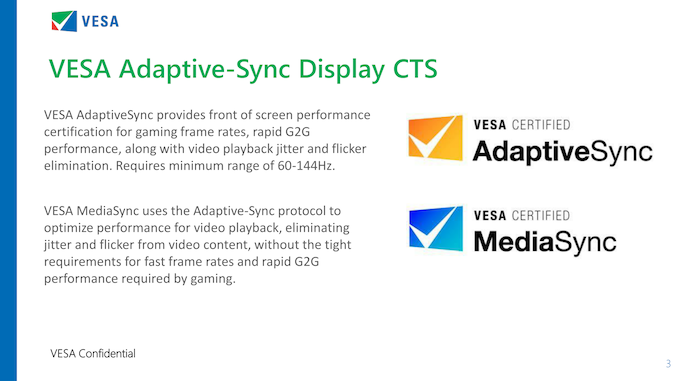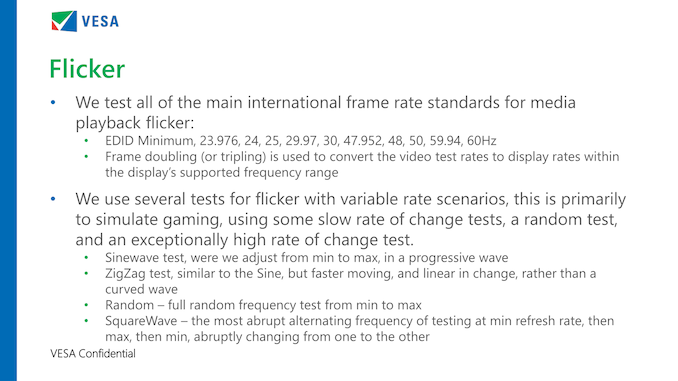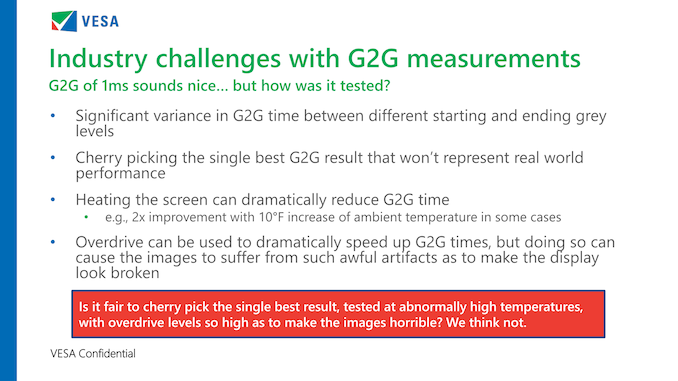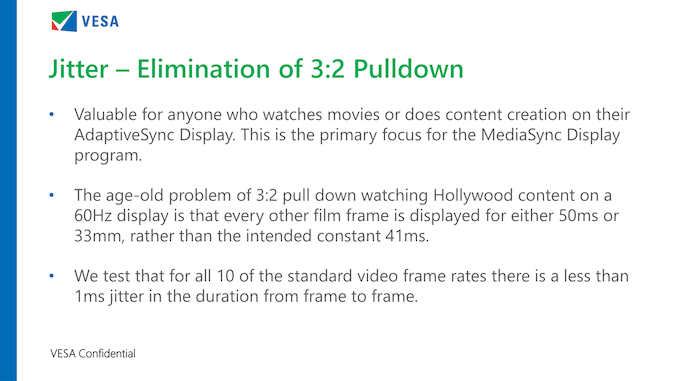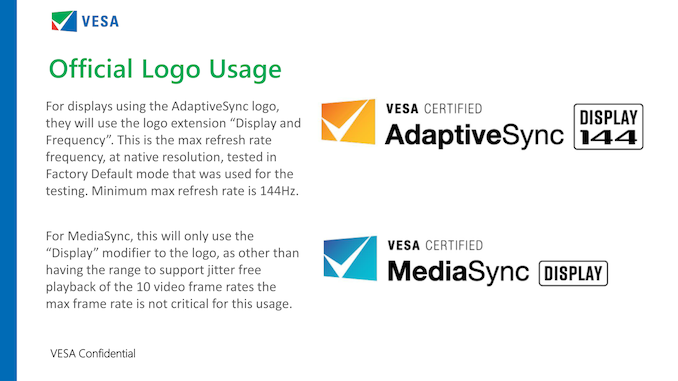
Original Link: https://www.anandtech.com/show/17367/vesa-launches-variable-refresh-display-perf-standards-adaptivesync-mediasync
VESA Launches Variable Refresh Display Performance Standards: AdaptiveSync and MediaSync
by Ryan Smith on May 2, 2022 9:00 AM EST
Kicking off what’s set to be a busy May, this morning the Video Electronics Standards Association (VESA), the PC display industry’s primary consortium, is rolling out a new set of performance standards for variable refresh rate displays. Dubbed AdaptiveSync and MediaSync, these new test standards are designed to offer an industry-neutral and open specification for the behavior and performance of DisplayPort displays. AdaptiveSync is a standard designed for high-end gaming displays, while MediaSync is aimed at eliminating video jitter on a much wider array of devices.
As a quick refresher, just under 8 years ago VESA introduced their Adaptive-Sync specification for DisplayPort monitors. Based on earlier variable refresh rate technology designed for embedded DisplayPort (eDP), Adaptive-Sync extended that technology to allow for full variable refresh rate operation as we have since come to know it in PC and laptop displays.
And while the introduction of Adaptive-Sync greatly increased the number of monitors with variable refresh rate capabilities on the market, it hasn’t been an entirely smooth experience. AMD was an early promotor of the technology with their Freesync initiative, which essentially piggybacked their own promotion and certification program on top of Adaptive-Sync, but also muddled things some with a Freesync HDMI standard and a weak base certification. Meanwhile NVIDIA was quite late to the game, though they did finally embrace support for the VESA standard in 2019 – adding Adaptive-Sync support alongside their existing proprietary G-Sync standard. But even after this, it’s left AMD and NVIDIA dueling to an extent with different standards and certification processes (and Intel looking on as the odd man out).
All the while, Adaptive-Sync-capable displays have been hit and miss, with a large variety in supported refresh rate ranges and a lot of inconsistency in how well variable refresh actually worked. Even today there are still displays that support variable refresh rates but deliver a subpar experience when doing so. All of this has hurt VESA’s efforts to promote the adoption of Adaptive-Sync technology, and ultimately for variable refresh displays to proliferate and be used to solve issues such as frame jitter.
To that end, today VESA is stepping in and will be taking on a much more active role in the standardization and marketing of Adaptive-Sync monitors. Recognizing that supporting the Adaptive-Sync feature alone isn’t enough, and that a good experience with a variable refresh rate monitor also requires boundaries and minimums in terms of performance, the group has put together two new logo programs to certify the performance of Adaptive-Sync displays. Or, as the group likes to put it, these new programs set standards for “front-of-screen performance”.
The primary purpose of these new logo programs is to help buyers identify monitors that proficiently implement Adaptive-Sync. There is also a secondary purpose of helping VESA’s member companies clearly communicate to those buyers that their variable refresh rate monitors are, to put it politely, legitimately good, since implementing Adaptive-Sync doesn’t come with any quality guarantees. This of course is an area that both NVIDIA and AMD have a hand in, with their G-Sync and Freesync certification programs respectively, with a mixed history of results thanks to multiple standards and the use of proprietary technologies. Consequently, VESA wants to do what neither of them already do in making a set of open standards that aren’t tied to a specific manufacturer, and rely purely on DisplayPort’s Adaptive-Sync technology.
VESA, in turn, is essentially going to be tackling the subject from both ends of the spectrum. At the high-end will be the new VESA Certified AdaptiveSync display standard, which is designed to be a conformance standard for high-end gaming displays and has some very tight requirements to match. At the other end of the spectrum is VESA Certified MediaSync, which is a far simpler specification aimed at flagging displays that offer basic and effective variable refresh rate support for media consumption purposes – and with no emphasis on gaming whatsoever. In practice, AdaptiveSync is a superset of MediaSync , so while both standards exist on the market you won’t see displays that are logo’d for both; if a display meets AdaptiveSync standards, then it’s more than good enough to also meet the needs of media playback.
AdaptiveSync: LFC, No Flicker, and No Shenanigans
We’ll start things off with a look at the high-end AdaptiveSync display standard. Designed for gaming displays (or more specifically, “gaming frame rates”), AdaptiveSync is a conformance test that takes a look at a number of factors. Not only are basic features such as refresh rates defined in the standards, but also standards for flicker (or rather the absence thereof), dropped frames, jitter, pixel response times (G2G), and ghosting/overshoot/undershoot. Short of HDR functionality (which is a whole other kettle of fish for numerous reasons), AdaptiveSync covers all the relevant requirements for a high-end gaming display.
All of which has come as a bit of a surprise to me. When VESA first informed me that they were working on a quality standard for variable refresh displays, I’ll freely admit that I was skeptical. The consensus-driven nature of the group means that VESA performance standards have at times been held back by the need to please hardware manufacturers who want to have many (if not all) of their products meet a new standard. This has most explicitly been the case for DisplayHDR certification, which although a technically sound program at the higher tiers, is harmed by the existence of the DisplayHDR 400 tier, making the DisplayHDR branding on its own kind of meaningless.
This is clearly something VESA has taken to heart, as, much to my surprise, AdaptiveSync isn’t making any such compromises. Instead, the group has gone all-in on developing a high-end specification that isn’t watered down to encompass or qualify more basic displays. As a result, most Adaptive-Sync-capable displays on the market right now won’t meet AdaptiveSync display standards, and even most gaming displays are likely going to fail as well. VESA set out to create a high-end standard, and they are clearly sticking to their guns on the matter to the very end.
And to be sure, the AdaptiveSync display standard is merely a performance standard – it does not define any new technologies. So the standard can be used to test and certify existing PC monitors, integrated displays (AIO PCs), and laptop displays, so long as those devices are hooked up via a DisplayPort/eDP standard. It should be noted that this technically means the AdaptiveSync standard only applies to the DisplayPort input on a device and not the HDMI inputs. But, as 99% of the hard work in delivering a good variable refresh rate experience occurs under the hood with components like the TCON and backlight, I would be surprised to see this be an issue.
Refresh Rates: 60-144 Minimum, LFC Required
Diving into the AdaptiveSync display standard itself, VESA has started things with significant refresh rate requirements. A compliant display needs to support a variable refresh rate range of at least 60Hz to 144Hz – the minimum, magical 2.4x range needed for low framerate compensation (LFC) support. Displays can go below this for the minimum (e.g. 48Hz) and above that for the maximum (see: 360Hz displays), but 60-144 is the smallest range that qualifies. And it must be out of the box; displays that need to be “overclocked” in any fashion to meet the minimums won’t quality. That goes for all testing, in fact, as AdaptiveSync certification testing is conducted with monitors running at their native resolution and set to their default, out-of-the-box configuration.
Along those lines, VESA is also testing for dropped frames, as there have apparently been some monitors that are accepting more frames than they can actually display. As a result, the conformance test looks for dropped frames both at fixed and variable refresh rates, to ensure every frame is being displayed.
Flicker: Testing Min to Max, and Everything In Between
The second major focus area for the AdaptiveSync conformance test is display flicker, which essentially covers a whole suite of display and backlight anomalies that can occur with variable refresh rate displays. Using a dedicated probe (presumably a photodiode), VESA’s testing regime looks for evidence of visible flicker, with a technical requirement of no more than -50 dB of flicker no matter the refresh rate. Here VESA is relying on the Japan Electronic Information Technology Association’s (JEITA) existing perception-based method for calculating flicker, which is weighted to look at the frequencies human eyes are most sensitive to.
The test, in turn, breaks things up into looking for flicker at common frame rates/refresh rates for media (23.976fps/71.928Hz, etc) and at the panel’s minimum refresh rate, as well as running several tests for flicker in full variable refresh rate scenarios, where the refresh rate is changing from frame to frame.
The conformance test for variable refresh mode relies on four refresh rate patterns in order to ensure displays can properly handle both slowly and quickly-changing refresh rates. Those patterns are a sinewave, a zigzag pattern, a square wave, and finally a full random test. According to VESA, the square wave test in particular is especially brutal since it calls for rapidly switching between minimum and maximum refresh rates. The random test is also quite capable of tripping up monitors, since it can have displays switching to significantly different refresh rates in one go, instead of smoothly ramping up or down.
And while the AdaptiveSync display conformance test doesn’t have an explicit test for backlight or gamma flicker (a somewhat common problem in early Adaptive-Sync displays), according to the group, they believe their flicker test should be sensitive enough to pick up on those specific phenomena.
AdaptiveSync Cont: G2G, Ghosting, & Pixel Response Times
Last, but not least – and certainly the most interesting – AdaptiveSync compliance also requires passing a battery of tests for pixel response times and overdrive overshoot/undershoot (i.e. ghosting). In fact, this is an area where VESA is being especially methodical, as not only is the group concerned with the image quality problems that come from ghosting, but they’re also putting their foot down on shenanigans involving Gray To Gray (G2G) pixel response times. As a result the pixel response time tests are geared to not only identify excessive ghosting, but they also define a very rigid (but sensible) test for measuring G2G response times.
For pixel response times, VESA is not so subtly taking aim at manufacturers’ current state of measuring and promoting G2G pixel response times, which can get creative at best, and exaggerative at worst. But despite those shenanigans, G2G response times remain an important metric: because G2G pixel transitions are some of the longest ones for LCD pixels (as opposed to black-to-white), they are the de facto standard for measuring overall response times. So as part of their overall pixel response time and ghosting testing for AdaptiveSync, VESA also needed to set a standard for measuring G2G response times.
The resulting methodology is essentially G2G testing with all of the shenanigans stripped out to avoid cherry-picking results. Among other things, VESA’s test requires an ambient (room) temperature of 22.5 to 24.5 Celsius (72.5F-76F) and that a panel has reached its equilibrium temperature. This is because the response times of liquid crystals varies with the temperature, and thus a display can produce unnaturally good times if the panel is heated. The size of the heating effect is actually rather surprising: according to VESA, they’ve seen some displays halve in response times just by increasing the ambient temperature by 5.5C.
Meanwhile, to avoid favoring any one G2G transition, VESA’s G2G testing instead involves averaging the results of 20 transitions amongst 5 different grey levels (black, dark grey, mid grey, light grey, white). This does mean that the resulting value is going to be better than the worst-case transition, but it also means that the resulting value will be worse than the best-case transition; on average, it balances out. Overall, an AdaptiveSync display requires an average G2G response time of less than 5ms, which is more than fast enough for a full transition on a 144Hz display with time to spare.
And, of course, the test looks at how well a display hits its target pixel value in order to ensure that the pixels aren’t being overdriven/underdriven by too much, which would result in visible ghosting. AdaptiveSync conformance requires that the highest G2G overshoot is under 20%, while the highest undershoot is even tighter at less than 15%. This is another case of the standard using perceptual boundaries, as a perfect result is all but impossible with overdrive, and a fast display is not possible without overdrive.
Notably, all of this testing is once again done with factory settings on a display. So although a display can offer multiple overdrive settings to satisfy a user’s preferences, the out-of-the-box mode needs to be the balanced mode, producing reasonably fast pixel response times without causing either ghosting (undershoot) or inverse ghosting (overshoot).
Variable Overdrive: Unneeded?
With all of that said, the pixel response time test does have a notable omission that monitor aficionados (and NVIDIA employees) will likely pick up on: variable overdrive testing. VESA’s testing does not explicitly test for overdrive at explicitly varying refresh rates, rather their testing is done in Adaptive-Sync mode which will have a display updating its pixels at what’s essentially their maximum refresh rate (e.g. 144Hz). It’s something that VESA has apparently put quite some thought into, as there’s actually a rather informative note about it in the AdaptiveSync Display FAQ:
When running in Adaptive-Sync mode, the refresh rate (i.e., the speed at which the data is transferred, frame by frame, to the display) and the speed at which the display scan out is occurring is always at maximum refresh rate. When frames are being updated at less than the maximum refresh rate of the panel, this is not because the panel is running any slower, but because the vertical blanking interval (VBlank) timing between frame to frame has increased. Therefore, there is no reason to test G2G/Overshoot/Undershoot at anything other than maximum refresh rate as that’s the only rate the panel will be operating at when in Adaptive-Sync mode. If you were to exit from Adaptive-Sync mode and change the display timing to a fixed rate timing, then and only then does the display clock rate and scan-out time change, at which point different G2G performance may occur. However, this is outside of the Adaptive-Sync mode and not included within the VESA Adaptive-Sync Display test.
In short, VESA believes that testing response times at multiple refresh rates is unnecessary, because in Adaptive-Sync mode displays should always be updating pixels at their maximum rate so that they’re ready for the next frame ASAP. This is a very interesting point, and one that will warrant a further look once there are monitors available that have passed the AdaptiveSync display conformance test. In the meantime it should be noted that this also doesn’t preclude displays using variable overdrive, as a display could implement it and still pass the conformance test.
Past that, variable overdrive has been a major component of NVIDIA’s G-Sync marketing for years now – and remains the differentiating factor between G-Sync (module) displays and G-Sync Compatible (VESA Adaptive-Sync) displays. So if VESA is right, then that could undermine the advantage (market or otherwise) of displays using NVIDIA’s G-Sync module.
AdaptiveSync: Supplementing Freesync & G-Sync
Finally, it’s worth emphasizing that the AdaptiveSync display standard is solely about setting performance metrics for variable refresh (Adaptive-Sync) displays. It doesn’t cover color gamuts, maximum brightness, viewing angles, or other image quality factors beyond those that relate to variable refresh operation (flicker, ghosting, etc).
And while VESA is focused on its own matters, it’s pretty much impossible to discuss AdaptiveSync without also discussing AMD and NVIDIA’s programs. While VESA is clearly looking to bring a bit of order (and transparency) to the process with their own standard, they’re not necessarily looking to usurp Freesync or G-Sync. Indeed, it’s fully within the allowances of the program that a monitor can be certified for both AdaptiveSync and a third-party variable refresh standard – or even both of them, making for a triple threat monitor.
But if we had to compare AdaptiveSync to the existing standards, at a high level AdaptiveSync looks fairly comparable to AMD’s FreeSync Premium and NVIDIA’s G-Sync Compatible standards. This isn’t terribly precise comparison since VESA is much more forthcoming about its response time and flicker requirements than AMD or NVIDIA, but at a minimum these are the tiers that all require a wide enough refresh range for LFC, as well as all of the flicker testing all three groups do.
Meanwhile I’d be remiss not to mention Intel here, who is in the process of (at last) rolling out their own contemporary discrete GPUs. Intel only gained variable refresh rate support in 2019 with the release of Ice Lake (10th Gen Core) SoCs, and as a result they currently only have a minimal stake in variable refresh displays. None the less, it’s not to Intel’s benefit that the current certification programs for Adaptive-Sync displays are run by their competitors, so VESA taking on the task in an industry-neutral fashion helps them as well by giving them a certification logo and product database they can point customers to. And over the longer run, Intel stands to benefit even more from the MediaSync display standard, since that’s likely to become a big deal on Intel’s core consumer market of laptops.
MediaSync
Shifting gears, let’s talk about VESA’s other new Adaptive-Sync performance standard, MediaSync. As opposed to the high-end AdaptiveSync spec, MediaSync is far more low-end, focused on ensuring proper variable refresh rate operation for media playback and only media playback. This standard doesn’t have any gaming-centric tests, and while the testing methods are shared with AdaptiveSync, that’s about where the similarities end.
The MediaSync display standard, in short, is a much narrower specification focused around an equally narrow refresh rate range of 48-60Hz. This is the golden zone for media playback, as it’s wide enough to cover everything from movies (23.976fps) and PAL TV (25/50fps) to full speed (60fps) PC content. As well, the standard has the same no-perceptual-flicker requirements as AdaptiveSync, and MediaSync-certified displays will still need to meet the same 20%/15% overshoot/undershoot requirements to ensure there isn’t any ghosting even at these lower refresh rates.
The big impetus behind MediaSync, beyond getting rid of display flicker, is putting a stake in jitter due to the mismatch between typical media framerates and PC display refresh rates. With most professional media content authored to 23.976, 3:2 pulldown jitter has been an issue for PCs for as long as they’ve had media playback capabilities. And since resolving it requires a relatively small range of refresh rates, variable refresh rate tech has always been well-primed to solve the matter.
In terms of technical specifications then, this means that MediaSync displays are limited to 1ms of jitter – frame-to-frame jitter must be no more than +/- 0.5ms. The spec, in turn, tests 10 different frame rates ranging from 23.976fps to 60fps, with testers employing frame doubling as necessary to bring up the lowest framerates to the refresh rate range of the display.
Compared to AdaptiveSync’s high standards, MediaSync’s requirements are something that should be attainable by a lot of monitors. So I wouldn’t be too surprised to see it show up on mid-range monitors, but even more than that, I expect this standard to be popular in the laptop market given how much media consumption is done on laptops these days.
Closing Thoughts
Wrapping things up, let’s talk about testing and logos for VESA’s new Adaptive-Sync performance standards.
Unlike DisplayHDR testing, OEMs cannot self-certify for AdaptiveSync/MediaSync compliance. Instead, all products must be sent to one of VESA’s approved Authorized Test Centers (ATCs), which the group already uses for things such as as certifying various DisplayPort devices. According to VESA, they are going this route because AdaptiveSync/MediaSync certification requires numerous specialized tools and significant know-how, which OEMs are unlikely to have access to. At the same time, it doesn’t hurt that this is another way which the new standards prevent shenanigans from OEMs by requiring a third-party prove that their products can meet the requirements.
That said, this does mean that certification will not come free. While OEMs do not need to pay VESA for the certification, they do need to pay the ATC for the testing. So the barrier to entry for a technically compliant display to get certified is very low, but it isn’t quite nil.
Once a display/product is certified, VESA has a unique logo for each program. For devices that pass AdaptiveSync conformance testing, the AdaptiveSync Display logo not only includes mention of the standard, but the display’s maximum refresh rate at its native resolution. This is to help communicate not only the maximum refresh rate of most monitors, but for the purposes of compliance testing on monitors with overdrive functionality, the refresh rate that the compliance testing was run at. Meanwhile MediaSync Display’s logo is more straightforward, and doesn’t make mention of refresh rates.
According to VESA, the final version of the standard was sent off to VESA members a few weeks ago. As usual for the group, they aren’t saying when we’ll see certified devices on the market since that’s up to their individual members. But, seeing as how there are some existing displays that should meet these standards, manufacturers should be able to promote their certification in short order – with updates to printed packaging to follow. Update: And indeed, LG is first out of the gate, announcing that both their 27GP850 and 27GP950 monitors are AdaptiveSync Display certified.
Finally, while the group hopes that they’ve knocked things out of the park with the first version of the AdaptiveSync/MediaSync standards, they’re also being quick to indicate that these standards aren’t set in stone. Should testing methods improve or OEMs find new and novel ways to pass certification, VESA is prepared to make further updates to the test suite. This is something they’ve already done once with DisplayHDR (which is now up to version 1.1), so there is precedent and experience here.

